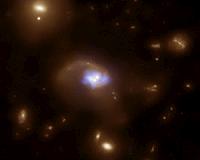 |
Boston MA (SPX) Jul 13, 2010 This composite image shows a powerful microquasar produced by a black hole in the outskirts of the nearby (12.7 million light years) galaxy NGC 7793. The large image contains data from the Chandra X-ray Observatory in red, green and blue, optical data from the Very Large Telescope in light blue, and optical emission by hydrogen ("H-alpha") from the CTIO 1.5-m telescope in gold. The upper inset shows a close-up of the X-ray image of the microquasar, which is a system containing a stellar-mass black hole being fed by a companion star. Gas swirling toward the black hole forms a disk around the black hole. Twisted magnetic fields in the disk generate strong electromagnetic forces that propel some of the gas away from the disk at high speeds in two jets, creating a huge bubble of hot gas about 1,000 light years across. The faint green source near the middle of the upper inset image corresponds to the position of the black hole, while the red (upper right) and yellow (lower left) sources correspond to spots where the jets are plowing into surrounding gas and heating it. The nebula being illuminated by the jets is clearly seen in the H-alpha image shown in the lower inset. The jets in the NGC 7793 microquasar are the most powerful ever seen from a stellar-mass black hole and the data show that a surprising amount of energy from the black hole is being released by the jets, rather than by radiation from material being pulled inward. The power of the jets is estimated to be about ten times larger than that of the very powerful ones seen from the famous microquasar in our own galaxy, SS433. This system in NGC 7793 is a miniature version of the powerful quasars and radio galaxies seen in more distant galaxies, which contain black holes that range from millions to billions of times the mass of the sun. A paper describing this work is being published in the July 8th, 2010, issue of Nature. The authors are Manfred Pakull from the University of Strasbourg in France, Roberto Soria from University College London, and Christian Motch, also from the University of Strasbourg.
Share This Article With Planet Earth
Related Links Chandra X-Ray Observatory Understanding Time and Space
 CID-42: A Black Hole 'Slingshot'
CID-42: A Black Hole 'Slingshot'Washington DC (SPX) Jul 02, 2010 Evidence for a recoiling black hole has been found using data from the Chandra X-ray Observatory, XMM-Newton, the Hubble Space Telescope (HST), and several ground-based telescopes. This black hole kickback was caused either by a slingshot effect produced in a triple black hole system, or from the effects of gravitational waves produced after two supermassive black holes merged a few million year ... read more |
|
| The content herein, unless otherwise known to be public domain, are Copyright 1995-2010 - SpaceDaily. AFP and UPI Wire Stories are copyright Agence France-Presse and United Press International. ESA Portal Reports are copyright European Space Agency. All NASA sourced material is public domain. Additional copyrights may apply in whole or part to other bona fide parties. Advertising does not imply endorsement,agreement or approval of any opinions, statements or information provided by SpaceDaily on any Web page published or hosted by SpaceDaily. Privacy Statement |